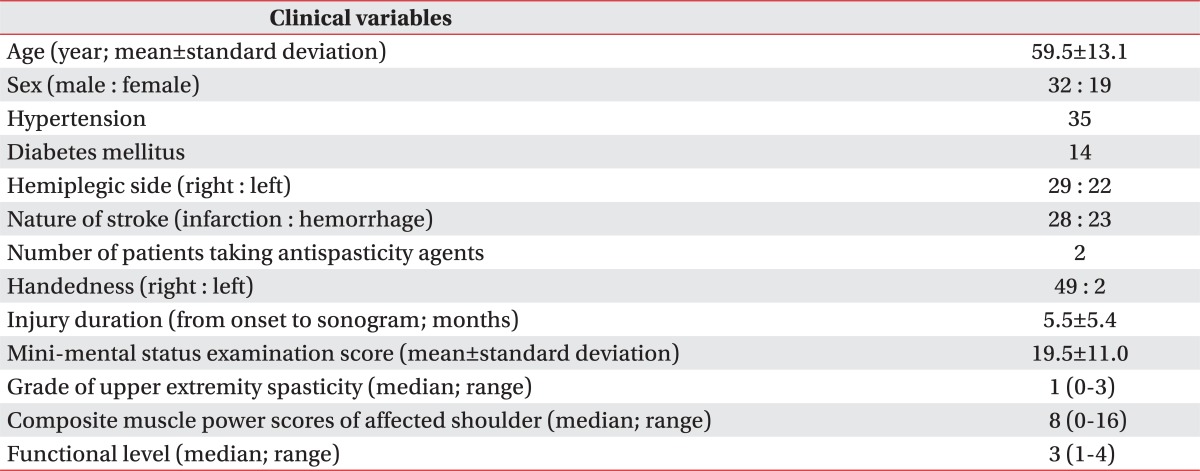1. Ko MH, Kim JY, Park SH, Kim NG, Seo JH. Comparison of ultrasonographic findings with clinical findings in hemiplegic shoulder. J Korean Acad Rehabil Med. 2006; 30:213–218.
2. Tallroth K. Shoulder imaging. A review. Ann Chir Gynaecol. 1996; 85:95–103. PMID:
8817045.
3. Lee IS, Shin YB, Moon TY, Jeong YJ, Song JW, Kim DH. Sonography of patients with hemiplegic shoulder pain after stroke: correlation with motor recovery stage. AJR Am J Roentgenol. 2009; 192:W40–W44. PMID:
19155379.

4. Hong JY, Jun PS, Son YG, Choi HW, Lee JH, Kang SH, Kim IT. Magnetic resonance arthrographic findings of the painful hemiplegic shoulder. J Korean Acad Rehabil Med. 2008; 32:657–663.
5. Papatheodorou A, Ellinas P, Takis F, Tsanis A, Maris I, Batakis N. Us of the shoulder: rotator cuff and non-rotator cuff disorders. Radiographics. 2006; 26:e23. PMID:
16352733.

6. Rutten MJ, Jager GJ, Blickman JG. From the rsna refresher courses: US of the rotator cuff: pitfalls, limitations, and artifacts. Radiographics. 2006; 26:589–604. PMID:
16549619.
7. Yang CP, Lee CL, Chen TW, Lee S, Weng MC, Huang MH. Ultrasonographic findings in hemiplegic knees of stroke patients. Kaohsiung J Med Sci. 2005; 21:70–77. PMID:
15825692.

8. Turner-Stokes L, Jackson D. Shoulder pain after stroke: a review of the evidence base to inform the development of an integrated care pathway. Clin Rehabil. 2002; 16:276–298. PMID:
12017515.

9. Lo SF, Chen SY, Lin HC, Jim YF, Meng NH, Kao MJ. Arthrographic and clinical findings in patients with hemiplegic shoulder pain. Arch Phys Med Rehabil. 2003; 84:1786–1791. PMID:
14669184.
10. Bonifer N, Anderson KM. Application of constraint-induced movement therapy for an individual with severe chronic upper-extremity hemiplegia. Phys Ther. 2003; 83:384–398. PMID:
12665409.

11. Moosikasuwan JB, Miller TT, Burke BJ. Rotator cuff tears: clinical, radiographic, and US findings. Radiographics. 2005; 25:1591–1607. PMID:
16284137.

12. Teefey SA, Middleton WD, Yamaguchi K. Shoulder sonography. State of the art. Radiol Clin North Am. 1999; 37:767–785. PMID:
10442080.
13. Schweitzer ME, Karasick D. MR imaging of disorders of the Achilles tendon. AJR Am J Roentgenol. 2000; 175:613–625. PMID:
10954440.

14. Bianchi S, Martinoli C. Ultrasound of the musculoskeletal system. 2007. Heidelberg: Springer;p. 248–259.
15. Holsbeeck MT, Introcaso JH. Muculoskeletal ultrasound. 2001. 2nd ed. Philadephia: Mosby;p. 474–487.
16. Lim JY, Koh JH, Paik NJ. Intramuscular botulinum toxin-a reduces hemiplegic shoulder pain: a randomized, double-blind, comparative study versus intraarticular triamcinolone acetonide. Stroke. 2008; 39:126–131. PMID:
18048857.
17. Bender L, McKenna K. Hemiplegic shoulder pain: defining the problem and its management. Disabil Rehabil. 2001; 23:698–705. PMID:
11732559.
18. O'Sullivan S, Schmitz T. Physical rehabilitation. 2007. 5th ed. Philadelphia: FA Davis;p. 753.
19. Van Ouwenaller C, Laplace PM, Chantraine A. Painful shoulder in hemiplegia. Arch Phys Med Rehabil. 1986; 67:23–26. PMID:
3942479.
20. Griffin J, Reddin G. Shoulder pain in patients with hemiplegia. A literature review. Phys Ther. 1981; 61:1041–1045. PMID:
6166017.
21. Chaco J, Wolf E. Subluxation of the glenohumeral joint in hemiplegia. Am J Phys Med. 1971; 50:139–143. PMID:
5579071.
22. Delisa JA, Gans BM. Physical medicine and rehabilitation. 2005. 4th ed. Philadelphia: Lippincott Williams & Wilkins;p. 1667.
23. Gowland C, Torrewin W, Van Hullenaar S. Basmajian JV, Wolf SL, editors. Therapeutic exercise for stroke patient. Therapeutic exercise. 1990. 15th ed. Baltimore: Lippincott Williams & Wilkins;p. 207–230.
24. Read JW, Perko M. Shoulder ultrasound: diagnostic accuracy for impingement syndrome, rotator cuff tear, and biceps tendon pathology. J Shoulder Elbow Surg. 1998; 7:264–271. PMID:
9658352.

25. O'Connor PJ, Rankine J, Gibbon WW, Richardson A, Winter F, Miller JH. Interobserver variation in sonography of the painful shoulder. J Clin Ultrasound. 2005; 33:53–56. PMID:
15674840.
26. Farin PU, Jaroma H. Sonographic findings of rotator cuff calcifications. J Ultrasound Med. 1995; 14:7–14. PMID:
7707483.
27. Rizk TE, Christopher RP, Pinals RS, Salazar JE, Higgins C. Arthrographic studies in painful hemiplegic shoulders. Arch Phys Med Rehabil. 1984; 65:254–256. PMID:
6712451.
28. Snels IA, Beckerman H, Twisk JW, Dekker JH, Peter De Koning , Koppe PA, Lankhorst GJ, Bouter LM. Effect of triamcinolone acetonide injections on hemiplegic shoulder pain: a randomized clinical trial. Stroke. 2000; 31:2396–2401. PMID:
11022070.





 PDF
PDF ePub
ePub Citation
Citation Print
Print





 XML Download
XML Download